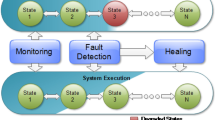Summary
A stable property in a distributed system is a global property which once true, remains true forever. This paper refines this notion by formally introducing the concept ofstrong stable properties. A strong stable property has the nice property that it can be correctly evaluated on the consistent part of uncoordinated snapshots. Termination and deadlock are shown to be strong stable properties, whereas distributed garbage is not. We also show how to derive a simple generic algorithm for the detection of a strong stable property. The generic algorithm is illustrated by two examples: termination detection and deadlock detection. Incidentally the paper presents a very simple algorithm for termination detection.
Similar content being viewed by others
References
Bevan DI: An efficient reference counting solution to the distributed garbage collection problem. Parallel Comput 9: 179–192 (1989)
Birman K, Schiper A, Stephenson P:Lightweight causal and atomic multicast. ACM Trans Comput Syst 9(3): 272–314 (1991)
Bracha G, Toueg S:Distributed deadlock detection. Distrib Comput 2: 127–138 (1987)
Chang EJ:Echo algorithms: depth parallel operations on general graphs. IEEE Trans Software Eng SE-8, 4: 391–401 (1982)
Chandy KM, Lamport L:Distributed snapshots: determining global states of distributed systems. ACM Trans Comput Syst 3(1): 63–75 (1985)
Chandy KM, Misra J, Haas LM:Distributed deadlock detection. ACM Trans Comput Syst 1(2): 144–156 (1983)
Chandrasekaran S, Venkatesan S:A message-optimal algorithm for distributed termination detection. J Parallel Distrib Comput 8: 245–252 (1990)
Dijkstra EW, Scholten CS:Termination detection for diffusing computations. Inf Proc Letters 11: 1–4 (1980)
Fidge C:Timestamps in message-passing systems that preserve the partial ordering. Proc 11th Australian Computer Science Conference, Univ of Queensland, February 1988
Goldberg B:Generational reference counting: a reduced-communication distributed storage reclamation scheme. Programming Languages Design and Implementation, Portland. ACM SIGPLAN Notices 24: 313–321 (1989)
Helary J.-M, Plouzeau N, Raynal M:Computing particular snapshots in distributed systems. Proc IEEE Int Phoenix Conference on Computers and Communications, March 1990, Scottsdale
Knapp E:Deadlock detection in distributed databases. ACM Comput Surv 19(4): 303–328 (1987)
Kshemkalyani AD, Singhal M:Correct two-phase and one-phase deadlock detection algorithms for distributed systems. Proc 2nd IEEE Symposium on Parallel and Distributed Processing, Dec 1990, Dallas, pp 126–129
Lai TH:Termination detection for dynamically distributed systems with non-first-in-first-out communication. J. Parallel Distrib Comput 3: 577–599 (1986)
Lamport L:Time, clocks, and the ordering of events in a distributed system. Commun ACM 21(7): 558–565 (1978)
Lai TH, Yang TH:On distributed snapshots. Inf Proc Letters 25: 153–158 (1987)
Marzullo K, Sabel L:Using consistent subcuts for detecting stable properties. TR 92-1277, Dept of Computer Science, Cornell University, 1992. A preliminary version appeared inProc 5th Int Workshop on Distributed Algorithms, Delphi Springer, Berlin Heidelberg New York, LNCS 579: 273–288 (1991)
Mattern F:Algorithms for distributed termination detection. Distrib Comput 2: 161–175 (1987)
Mattern F:Virtual time and global states of distributed systems. In: Cosnard M, Robert Y, Quinton P, Raynal M (eds); Parallel and distributed algorithms. North-Holland, pp 215–226, 1989
Raynal M:Distributed computation and networks. MIT Press, 1988
Singhal M:Deadlock detection in distributed systems. IEEE Comput 22(11): 37–48 (1989)
Tel G:Distributed infimun approximation. TR Dept of Computer Science, Utrecht University, 1986
Tel G, Mattern F:The derivation of distributed termination detection algorithms from garbage collection schemes. ACM Trans Program Lang Syst 15(1): 1–35 (1993)
Tel G, Tan RB, van Leeuwen J:The derivation of graph marking algorithms from distributed termination detection protocols. Sci Comput Program 10: 107–137 (1988)
Wegner P:Concepts and paradigms of object-oriented programming. ACM OOPS Messenger 1: 7–87 (1990)
Author information
Authors and Affiliations
Additional information
Andre Schiper has been a professor of Computer Science at EPFL (Federal Institute of Technology in Lausanne, Switzerland) since 1985, leading the Operating Systems laboratory. He graduated in Physics from the Federal Institute of technology in Zürich and received his Ph.D. in Computer Science from EPFL in 1980. In 1981–82 he spent one year at the University of Rennes, France. From 1983 to 1985, he was professor at the Engineering School in Yverdon, Switzerland. Between 1989 and 1991 André Schiper was head of the Department of Computer Science of EPFL, and during the academic year 1992–93 he was on sabbatical leave at Cornell University, Ithaca (NY). His research interests are in the areas of operating systems, distributed and fault-tolerant distributed systems, and parallelism. He is currently involved in the European Esprit project BROADCAST whose objective is the design and implementation of large scale distributed computing systems.
Alain Sandoz graduated in Mathematics from the University of Neuchâtel, Switzerland, in 1984 and in Computer Science from the Federal Institute of Technology in Lausanne, Switzerland, in 1988. He received his Ph.D. in Computer Science from the Federal Institute of Technology in Lausanne in 1992. His dissertation was concerned with modelling causal relationships between transactions in distributed and replicated database systems. From 1992 to 1994 he was involved in research on fault-tolerant and large scale distributed computing systems. He is currently working on the development of information systems for the Swiss government.
Rights and permissions
About this article
Cite this article
Schiper, A., Sandoz, A. Strong stable properties in distributed systems. Distrib Comput 8, 93–103 (1994). https://doi.org/10.1007/BF02280831
Received:
Accepted:
Issue Date:
DOI: https://doi.org/10.1007/BF02280831




